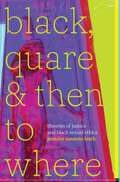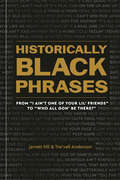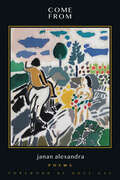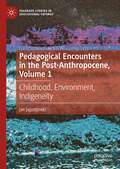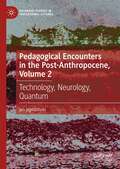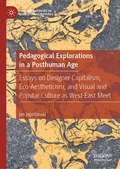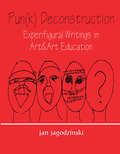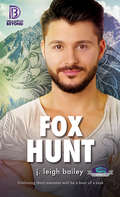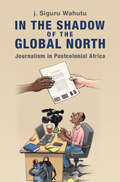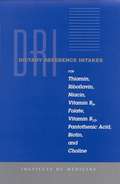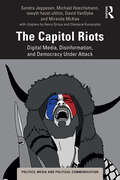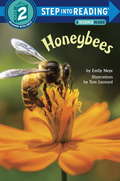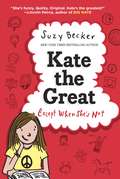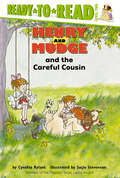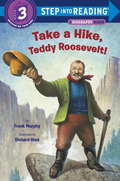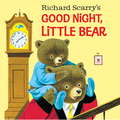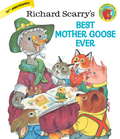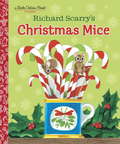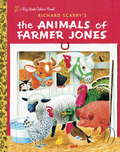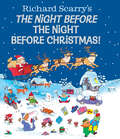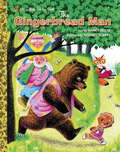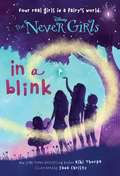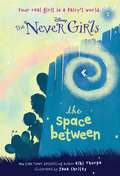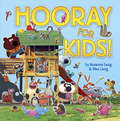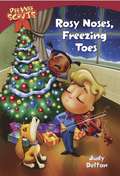- Table View
- List View
Black, Quare, and Then to Where: Theories of Justice and Black Sexual Ethics (Religious Cultures of African and African Diaspora People)
by jennifer susanne leathIn Black, Quare, and Then to Where jennifer susanne leath explores the relationship between Afrodiasporic theories of justice and Black sexual ethics through a womanist engagement with Maât the ancient Egyptian deity of justice and truth. Maât took into account the historical and cultural context of each human’s life, thus encompassing nuances of politics, race, gender, and sexuality. Arguing that Maât should serve as a foundation for reconfiguring Black sexual ethics, leath applies ancient Egyptian moral codes to quare ethics of the erotic, expanding what relationships and democratic practices might look like from a contemporary Maâtian perspective. She also draws on Pan-Africanism and examines the work of Alice Walker, E. Patrick Johnson, Cheikh Anta Diop, Sylvia Wynter, Sun Ra, and others. She shows that together these thinkers and traditions inform and expand the possibilities of Maâtian justice with respect to Black sexual experiences. As a moral force, leath contends, Maât opens new possibilities for mapping ethical frameworks to understand, redefine, and imagine justices in the United States.
Historically Black Phrases: From "I Ain't One of Your Lil' Friends" to "Who All Gon' Be There?"
by jarrett hill Tre'vell AndersonA fun and thoughtful dictionary of Black language you didn&’t know you needed, Historically Black Phrases is a love letter to the Black community and the ways it drives culture.&“This perfect blend of explanation, definition and social commentary will have you laughing while learning.&”—George M. Johnson, New York Times bestselling author of All Boys Aren't Blue and We Are Not BrokenBlack vernacular doesn&’t often get its due—despite its enormous influence on mainstream culture—but Historically Black Phrases is here to give Black language its flowers. A celebration of more than two hundred staples of Black conversation—from church sayings and units of measure to compliments and reprimands—this sharp and witty guide explores the unique importance of Black expression and communication. Historically Black Phrases offers definitions and notable pop culture moments, as well as tips on pronunciation and usage of phrases like &“feelin&’ yourself,&” &“don&’t get it twisted,&” and &“pop off.&” In addition to the phrases, short essays offer insight on different facets of Black language from scholars, entertainers, and pop culture commentators (i.e., everybody and they mama). Authors, journalists, and hosts of the award-winning podcast FANTI, jarrett hill and Tre&’vell Anderson examine each phrase with humor and cultural precision, making Historically Black Phrases a vital ode to how Black language influences the world.
come from
by janan alexandraFOREWORD BY ROSS GAYHere is a collection that pulses with warmth and vitality, heralding the arrival of a fresh and vibrant voice on the poetry scene. Clear and concise, accessible and profound, janan alexandra’s debut poetry collection COME FROM weaves from English to Arabic, exploring the joint projects of longing and belonging.Part love song for the speaker’s mother and part grief song for ongoing postcolonial loss, this book reaches for, around, and through language—feeling for its limits and possibilities. COME FROM searches for what might be possible if we dislodge our practices of belonging, divest from nation and state, and instead turn deeply toward each other. Drawing on both narrative and lyric impulses, alexandra invites readers into a world bristling with family, memory, home, and inheritance—all in the wake of dislocation and fracture. In one section of the book, we follow the speaker “back home” after years of separation; later, we encounter a series of parables in the form of an Arabic abecedarian, through which the speaker recovers parts of her mother tongue—invoking personal and communal histories marked with the longue durée of empire.COME FROM investigates what is deeply interior while reaching toward the world with tenderness and generous attention.
Pedagogical Encounters in the Post-Anthropocene, Volume 1: Childhood, Environment, Indigeneity (Palgrave Studies in Educational Futures)
by jan jagodzinskiThis volume, the first of a two volume set, addresses three major areas in response to the post-Anthropocene: childhood, environment and indigeneity. Each of these areas is broadly addressed in relation to the concerns that have arisen both theoretically and educationally. The author terms these to be encounters as each area presents a particular problematic when addressing the phase change that the planet is undergoing where the anthropogenic labour of global humanity is contributing to climate change, endangering our very existence. There has been a concerted effort to overcome the nature-culture divide in education. The author reviews this development in the first section where there has been a particular emphasis placed on childhood education. In the second section he turns to the pedagogical theories that are attempting to overcome this same divide in environmental and science education. The last section attempts to bring into the conversation the vast literature on Indigeneity and their attempts to revise traditional education to meet these extraordinary times.
Pedagogical Encounters in the Post-Anthropocene, Volume 2: Technology, Neurology, Quantum (Palgrave Studies in Educational Futures)
by jan jagodzinskiAs a follow up to Pedagogical Encounters in the Post-Anthropocene, Volume I, this book addresses three major areas in response to the post-Anthropocene: Technology, Neurology, Quantum. Each of these areas is broadly addressed in relation to the concerns that have arisen both theoretically and educationally. As in Volume I, the author terms these to be encounters as each area presents a particular problematic when addressing the phase change that the planet is undergoing where the anthropogenic labour of global humanity is contributing to climate change, endangering our very existence. Technology in education has been a significant development. There is a concerted effort to review this development placing stress on the rise of learning machines and algorithms. In the second encounter the vast literature on neurology is addressed, especially neurodiversity and the various symptoms that have emerged in the post-Anthropocene era. The last section reviews issues related to quantum theory as this is fundamental to tensions between physics and metaphysics. The volume concludes with the author’s own pedagogical proposal for the future.
Pedagogical Explorations in a Posthuman Age: Essays on Designer Capitalism, Eco-Aestheticism, and Visual and Popular Culture as West-East Meet (Palgrave Studies in Educational Futures)
by jan jagodzinskiThis book problematizes the role of education in an increasingly mediatized world through the lenses of creativity, new media, and consumerism. At the core of the issue, the author argues, creativity in art education is being co-opted to serve the purposes of current economic trends towards designer capitalism. Using an East meets West approach, jagodzinski draws on Deleuze and Guattarian philosophy to explore visual and popular culture in Korean society, addressing the tensions that exist between designer education and art that explores the human condition. In doing so, he challenges art educators to envision a new paradigm for education which questions established media ontologies and incorporates new ways to confront the crisis of the Anthropocene.
Pun: Experifigural Writings in Art&art Education (Studies in Curriculum Theory Series)
by jan jagodzinskiIn Postmodern Dilemmas: Outrageous Essays in Art&Art Education and Pun(k) Deconstruction: Experifigural Writings in Art&Art Education, jan jagodzinski presents a series of essays covering a timespan of approximately ten years. These essays chart the theory and practice of art&art education as it relates to issues of postmodernity and poststructuralism concerning representation, identity politics, consumerism, postmodern architecture, ecology, phallocentrism of the artistic canon, pluriculturalism, media and technology, and AIDS. As a former editor of The Journal of Social Theory in Art Education and a founding member for the Caucus on Social Theory in Art Education, the author attempts to deconstruct the current art education paradigm, which is largely based on modernist tenets, and to reorient art education practice to social issues as developed in both media education and cultural studies. Part of the intent in these two volumes is to undertake a sustained critique of the 1982 Art in the Mainstream (A.I.M.) statement, which continues to be considered as the core value for art education. The distinct intention of this critique is to put forward a new value base for art&art education in these postmodern times. Many of the essays raise the need to be attentive to sex/gender issues in art&art education and the need to read the artistic discourse "otherwise." There is a sustained critique of the art programs developed by the Getty Center for the Arts, whose arts curriculum presents the paradigm case of late modernist thinking. Some essays are written in a provocative form that tries to accommodate such content. This is particularly the case in Pun(k) Deconstruction, where architectural discourse is deconstructed, and which includes an "artistic performance" given by the author in 1987. This singular set of volumes combines scholarship in the areas of gender studies, aesthetics, art history, art education, poststructuralism, and cultural studies in a unique blend of theory and practice for rethinking the field of art education.
Fox Hunt (Dreamspun Beyond #37)
by j. leigh baileyA Shifter U TaleOutfoxing their enemies will be a bear of a task. Aspiring journalist and fox shifter David ends up with a target on his back after hacking the Moreau Initiative, the shifter world’s greatest enemy. But he won’t let that stop him from the campus tour road trip that’ll help him become the next Anderson Cooper… even if his family insists he travel with a grumpy grizzly bear bodyguard. Buddy Brady is older, sexy, and too damn distracting for David, and as the sexual tension builds, so does the suspicion around the repeated attacks—first in Chicago, then in New York. Someone is tracking them, and all clues point to a traitor in the shifter ranks. Worst of all, they could be after David’s family....
In the Shadow of the Global North: Journalism in Postcolonial Africa (Communication, Society and Politics)
by j. Siguru WahutuIn the Shadow of the Global North unpacks the historical, cultural, and institutional forces that organize and circulate journalistic narratives in Africa to show that something complex is unfolding in the postcolonial context of global journalistic landscapes, especially the relationships between cosmopolitan and national journalistic fields. Departing from the typical discourse about journalistic depictions of Africa, j. Siguru Wahutu turns our focus to the underexplored journalistic representations created by African journalists reporting on African countries. In assessing news narratives and the social context within which journalists construct these narratives, Wahutu captures not only the marginalization of African narratives by African journalists but opens up an important conversation about what it means to be an African journalist, an African news organization, and African in the postcolony.
DRI DIETARY REFERENCE INTAKES: FOR Thiamin, Riboflavin, Niacin, Vitamin B6, Folate, Vitamin B12, Pantothenic Acid, Biotin, and Choline
by Standing Committee on the Scientific Evaluation of Dietary Reference Intakes its Panel on Folate Other B Vitamins Choline Subcommittee on Upper Reference Levels of NutrientsSince 1941, Recommended Dietary Allowances (RDAs) has been recognized as the most authoritative source of information on nutrient levels for healthy people. Since publication of the 10th edition in 1989, there has been rising awareness of the impact of nutrition on chronic disease. In light of new research findings and a growing public focus on nutrition and health, the expert panel responsible for formulation RDAs reviewed and expanded its approach--the result: Dietary Reference Intakes.This new series of references greatly extends the scope and application of previous nutrient guidelines. For each nutrient the book presents what is known about how the nutrient functions in the human body, what the best method is to determine its requirements, which factors (caffeine or exercise, for example) may affect how it works, and how the nutrient may be related to chronic disease.This volume of the series presents information about thiamin, riboflavin, niacin, vitamin B6, folate, vitamin B12, pantothenic acid, biotin, and choline.Based on analysis of nutrient metabolism in humans and data on intakes in the U.S. population, the committee recommends intakes for each age group--from the first days of life through childhood, sexual maturity, midlife, and the later years. Recommendations for pregnancy and lactation also are made, and the book identifies when intake of a nutrient may be too much. Representing a new paradigm for the nutrition community, Dietary Reference Intakes encompasses: Estimated Average Requirements (EARs). These are used to set Recommended Dietary Allowances.Recommended Dietary Allowances (RDAs). Intakes that meet the RDA are likely to meet the nutrient requirement of nearly all individuals in a life-stage and gender group.Adequate Intakes (AIs). These are used instead of RDAs when an EAR cannot be calculated. Both the RDA and the AI may be used as goals for individual intake.Tolerable Upper Intake Levels (ULs). Intakes below the UL are unlikely to pose risks of adverse health effects in healthy people. This new framework encompasses both essential nutrients and other food components thought to pay a role in health, such as dietary fiber. It incorporates functional endpoints and examines the relationship between dose and response in determining adequacy and the hazards of excess intake for each nutrient.
The Capitol Riots: Digital Media, Disinformation, and Democracy Under Attack (Politics, Media and Political Communication)
by Michael Hoechsmann Sandra Jeppesen iowyth hezel ulthiin David VanDyke Miranda McKeeThe Capitol Riots maps out the events of the January 6, 2021 insurrectionary riots at the United States Capitol building, providing context for understanding the contributing factors and ongoing implications of the uprising. This definitive text explores the rise of populism, disinformation, conspiracy theories, the alt-right, and white supremacy during the lead-up to and planning of the Stop the Steal campaign, as well as the complex interplay during the riots of political performances, costumes, objectives, communications, digital media, datafication, race, gender, and—ultimately—power. Assembling raw data from social media, selfie photos and videos, and mainstream journalism, the authors develop a timeline and data visualizations representing the events. They delve into the complex, openly shared narratives, motivations, and actions of people on the ground that day who violated the symbolic center of U.S. democracy. An analysis of visual data reveals an affective outpouring of mutually amplifying expressions of frustration, fear, hate, anger, and anomie that correspond to similar logics and counter-logics in the polarized and chaotic contemporary media environment that have only been intensified by COVID-19 lockdowns, conspiracy theories, and a call to action at the Capitol from the outgoing POTUS and his inner circle. The book will appeal to both a general audience of those curious about how and why the Capitol riots unfolded and to students and scholars of communications, political science, media studies, sociology, education, surveillance studies, digital humanities, gender studies, critical whiteness studies, and datafication studies. It will also find an audience within computer science and technology studies through its approach to big data, data visualization, AI, algorithms, data tracking, and other data sciences.
Honeybees (Step into Reading)
by Emily Neye illustrations by Tom LeonardThis Step 2 Step into Reading Science Reader teaches kids how honeybees make honey, build their hives, and . . . dance! Buzz-worthy facts will cross-pollinate beautifully with classroom learning. This reissued edition includes a new author's note about Colony Collapse Disorder, the phenomenon threatening the honeybee population today. Step 2 Readers use basic vocabulary and short sentences to tell simple stories. For children who recognize familiar words and can sound out new words with help.
Kate the Great, Except When She's Not (Kate the Great #1)
by Suzy Becker illustrated by Suzy BeckerFans of Wimpy Kid and Dork Diaries will love this illustrated series by the "New York Times" bestselling author of "All I Need to Know I Learned from My Cat. " Meet Kate Geller, a sassy flute-playing artist, who comes up with an original way to redefine friendship. Kate's older sister is way too perfect. Her younger sister is way too cute. And her mom wants her to be pals with her frenemy, Nora. Her art teacher, Mrs. Petty, is way too uncreative, and how can Kate pay attention at Junior Guides when her pod leader has a sweat stain the size of the town beach? Now she has to get through her Christopher Columbus role during Discovery Day and her "Colonial Buddies" report, but little does she know how much "help" she'll be getting from Eleanor Roosevelt and Albert Einstein. This humorous debut novel features more than 350 illustrations. "From the Hardcover edition. "
Henry and Mudge and the Careful Cousin (Henry and Mudge #13)
by Cynthia Rylant illustrated by Sucie StevensonIn the 13th book in the Henry and Mudge series, Henry and his big dog Mudge can't wait for Cousin Annie to visit. But when Annie arrives, she thinks Henry's fish tank smells and does not like dog kisses. How can you have fun with a cousin like that? Henry and Mudge find a way!
Take a Hike, Teddy Roosevelt! (Step into Reading)
by Frank Murphy illustrated by Richard WalzA Step 3 Step into Reading Biography Reader about Teddy Roosevelt and his efforts to protect our environment and establish national parks. Teddy battled asthma all his life, and the list of things he shouldn't do was long. But when people told him "you can't," he set about proving them wrong. This book focuses on his inexhaustible enthusiasm and his commitment to preserving America's natural resources. Step 3 Readers feature engaging characters in easy-to-follow plots about popular topics. For children who are ready to read on their own.
Good Night, Little Bear (Little Golden Book)
by illustrated by Richard Scarry Patricia M. ScarryFirst a story, and then a kiss from Mother Bear, and Father Bear carries Little Bear to bed. And that's when the fun begins. Father Bear gets to Little Bear's room, but Little Bear is missing! Little readers will see him hiding in the MOST obvious place but Father Bear cannot seem to find him. Is he under the stove? Is he in the garden? Is he in the woodbox? Only when Father Bear walks past the mirror does the silliness end, and in a very tasty way. With this, one of the most charming bedtime tales ever, Richard Scarry has once again proven his timeless appeal.
Richard Scarry's Best Mother Goose Ever!
by illustrated by Richard Scarry WrittenRichard Scarry introduces toddlers to the nursery rhymes of Mother Goose! Featuring his unmistakable art (now restored to its original glory) and fifty of Mother Goose's most beloved rhymes, Scarry's timeless collection, now celebrating its fiftieth anniversary, is a must-have for readers of all ages.From the Hardcover edition.
Richard Scarry's Christmas Mice
by illustrated by Richard Scarry WrittenA timeless Richard Scarry Christmas tale of two little mice waiting for Santa is now available as a Little Golden Book! In this Richard Scarry Christmas classic, now a Little Golden Book, little ones will meet two little mice who've discovered the candy, dolls, and even a race car that Santa brought. But did Santa leave anything for the two little mice? Children will love the happy ending in this sweet story from the 1960s, with its charming illustrations digitally restored to their original brilliance.
Richard Scarry's The Animals of Farmer Jones (Big Little Golden Book)
by illustrated by Richard Scarry Leah GaleIt is suppertime on the farm. The animals are very hungry. But where is Farmer Jones?The cow jangles her bell. "Moo, moo," says the cow. "I am very hungry." But where is Farmer Jones?Published 50 years ago, this simple, satisfying story is illustrated in Richard Scarry's early, more painterly style.
Richard Scarry's The Night Before the Night Before Christmas!
by Richard Scarry illustrated by Richard ScarryRichard Scarry and Christmas combine to create this adventurous holiday picture book! It's Christmas, and Richard Scarry's beloved cast of Busytown characters are gearing up for the holiday! And nobody is more excited than Mr. Frumble. In fact, he's so excited he sets out for the North Pole to become one of Santa Bear's helpers. But when Santa Bear mixes up the dates and starts his deliveries the night before the night before Christmas, it's up to the ever-clumsy Mr. Frumble to save the holiday for his Busytown friends! Full of detailed illustrations, humor, and adventure, The Night Before the Night Before Christmas! is the perfect way for children--and Scarry fans of all ages--to celebrate the holiday season.
The Gingerbread Man (Little Golden Book)
by Nancy Nolte illustrated by Richard ScarryRUN, RUN as fast as you can. You can’t catch me— I’m the Gingerbread Man! Recently discovered in the Golden Books archive, this favorite folktale has been out of print for over 30 years. The early painterly art style of Richard Scarry looks new and fresh again in this keepsake edition. His lively images will run off the pages and into the hearts of a new generation of children.
Never Girls #1: In a Blink (Disney Fairies)
by Kiki Thorpe illustrated by RH DisneyThe Disney Fairies star in a magical all-new early chapter book series for kids ages 6 to 10-The Never Girls! The smell of salt water, a gust of seabreeze, and the bell-like ringing of a fairy's laugh are the only hints that something magical is happening to Kate, Mia, Lainey, and Gabby. In a blink of an eye, the four friends are whisked out of their ordinary lives to the most wonderful place of all-Never Land, home to fairies, mermaids . . . and now four lost girls. The girls don't want to leave right away, but Queen Clarion and Tinker Bell have figured out a way for them to get home. Will Kate, Mia, Lainey, and Gabby's fantastic adventure end before it's barely begun?
Never Girls #2: The Space Between (Disney Fairies)
by Kiki Thorpe illustrated by RH DisneyThe Disney Fairies star in a magical all-new early chapter book series for kids ages 6 to 10-The Never Girls! It's not fair! Just as they were settling in at Pixie Hollow, Kate, Mia, Lainey, and Gabby have to go home! Tinker Bell says no kids have ever come back to Never Land, but Lainey refuses to believe it. Will she never get to ride a deer through the woods again? And how can she learn the languages of animals without the fairies' help? But even when they leave Never Land, its magic seems to follow them! That mouse in Lainey's kitchen-she's sure it was one of the fairies' dairy mice! Is there some kind of a splinter between the worlds?
Hooray for Kids!
by Suzanne Lang illustrated by Max LangEvery kid is a one-of-a-kind kid! Suzanne and Max Lang (Families, Families, Families!) bring us another joyful ode to diversity in this zippy rhyming celebration of kids of all stripes. Whether you're a play-a-lot-of-ball kid, a hang-out-at-the-mall kid, a bake-delicious-pie kid, or an always-asking-why kid . . . when you read this book, you'll be a laughing-till-you-cry kid! Children can find themselves in the hilarious menagerie and recognize their friends and classmates. The subtle anti-bullying message will make this a welcome addition to classroom libraries.
Pee Wee Scouts: Rosy Noses, Freezing Toes (Pee Wee Scouts)
by Judy Delton illustrated by Alan TiegreenJINGLE BELL ROCK Stars? The Scouts are having a holiday party to show off their musical talents. Molly plans to sing “Rudolph the Red-Nosed Reindeer. ” And Rachel wants to perform Hanukkah songs on the piano. But notallthe Scouts are ready for the concert. Sonny hates the violin so much, he’d rather run away from home than play it! He disappears, and the Pee Wees have to work together to find their friend. Can they bring Sonny home for the holidays?
